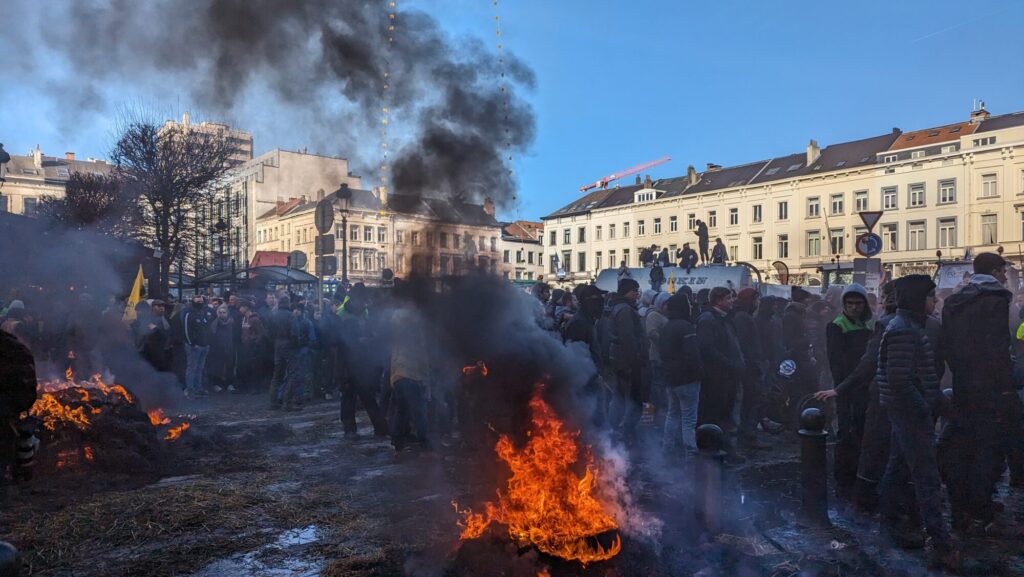Canadian Politics, Culture, International Politics, Politics, Travel Journalism
How Covid fuelled a 21st century Peasant’s Revolt
As I write, dozens of tractors, one with an enormous manure spreader hitched to it, are blockading off a street near our Brussels office. They moved in during the night and are now hemmed in by police; most of the farmers look like they slept in their cabs. By 10 a.m., a half-dozen or so men and one young woman had set up an open-air barbeque in the park and opened some beers while reporters took photographs. The farmers are French; more are expected to arrive soon. A blockade is going on in Paris, too. On Friday, I attended a farmers’ protest in front of the EU with several of my colleagues—that one had fewer tractors but featured a large cow painted in EU blue hanging by its neck from a loader, while French politician Marion Maréchal, the blond darling of the French Right, gave supportive interviews.
Farmer protests have become a feature of European politics, with tractors rumbling down city streets in the Netherlands, Belgium, Germany, France, Poland, and Italy in response to pressure on agricultural livelihoods from top-down environmental regulations and other policies. They also represent a relatively new trend: right-leaning protestors utilizing civil disobedience to confront state institutions. Traditionally, such tactics have been favored by leftist demonstrators, especially environmentalist groups such as Extinction Rebellion. A rare example of a socially conservative movement using civil disobedience as a primary tactic was the anti-abortion ‘rescue’ movement, which resulted in 70,000 arrests in the United States in the 1980s and early ‘90s. Copycat protests occurred worldwide; in France, they were led by Noelia Garcia, a model-turned activist dubbed ‘the Lipstick Commando’ for her arrests blocking Parisian abortion clinics.
Farmers’ protests cannot be uniformly characterized as necessarily right-wing; the ideologically diverse participants are merely united behind shared goals. Nonetheless, the international press insists that the farmer protests are either an iteration of the ‘far Right’ or an unwitting vehicle for conservative populism. The protests have also become inextricably intertwined with right-wing politics because only conservatives seem to support them—Maréchal was joined at last week’s demonstration by Hungarian conservatives as well as representatives of Spain’s Vox Party and conservative MEPs such as Rob Roos of the Netherlands. In Canada, the trucker-led Freedom Convoy of early 2022 was universally opposed by leftists but supported by many Tory MPs.
It was arguably the Freedom Convoy, in which hundreds of trucks descended on Ottawa and set up camp for weeks to protest job-killing government vaccine mandates, which popularized the concept of vehicular civil disobedience. The Trudeau government’s crackdown on the convoy, which included the invocation of the Emergency Measures Act and the mass freezing of bank accounts, was a brazen display of state power. A federal judge recently ruled that Trudeau’s use of the Emergency Act was unconstitutional and violated the Canadian Charter of Rights and Freedoms, breaking the highest law in the land to illegally suppress citizens. (The Trudeau government insists their actions were justified and plans to appeal the decision, and it is worth noting that if the Tories made the same claim, they would be accused of undermining the rule of law.)
The Freedom Convoy, the farmers’ protests, and similarly confrontational populist demonstrations have more in common than just tactics. The increasing willingness to resort to civil disobedience when pushing back against government policies is a direct reaction to the state’s exercise of power in response to the COVID pandemic. The overnight curtailing of civil liberties and the often-vicious government response to dissent was a political and cultural inflection point that most politicians have not yet begun to understand, much less grapple with. The societal fault lines already made visible by the growing success of populist movements around the world turned into canyons as people radicalized in response to the realization that their governments had far more power than they had ever imagined—and that this could impact every aspect of their lives.
The COVID pandemic, only a few years in the past, already seems like a blur. The initial panic producing long lines at supermarkets as people scrambled to stock up on supplies; the lockdowns and restrictions on businesses and social gatherings while people attempted to figure out how to pay their bills and survive; breadwinners being told they were ‘non-essential’; and entire metropolises turned into ghost towns. I will never forget the sick feeling in my stomach driving down silent streets through an empty city center during lockdown—not a sign of life to be seen. I sometimes find it hard to believe it happened.
The collective trauma of COVID was exacerbated by the fact that people experienced it so differently; the virus seemed custom-made to produce paranoia and conspiracy theories. My elderly grandmother got over COVID in a week; a young, healthy friend ended up in the hospital for weeks and nearly died. But it was the cruel impact of COVID measures, which have rarely even been acknowledged by those who implemented them, that changed everything. We all know the stories. Those who died with loved ones sobbing in the parking lot, barred from their bedsides; the final goodbyes between family members that took place over video call; the funerals that were banned, restricted to a handful, or rigorously policed by law enforcement, who transformed overnight into enforcers of the COVID regime. Following all of that were the vaccine mandates and the demonization of those who declined.
READ THE REST OF THIS COLUMN AT THE EUROPEAN CONSERVATIVE
SUBSCRIBE TO THE SUBSTACK NEWSLETTER FOR REGULAR UPDATES








